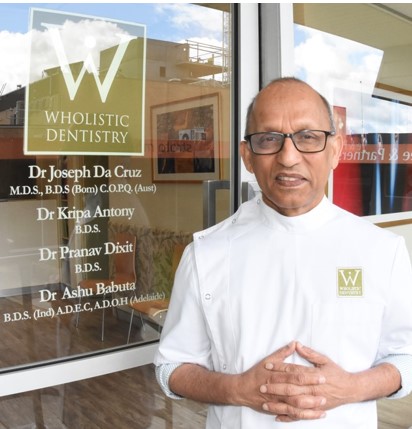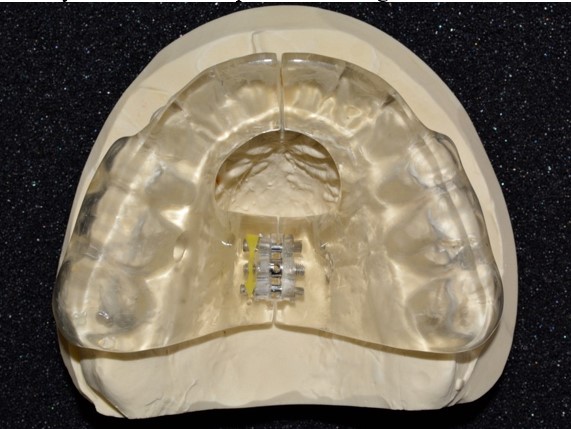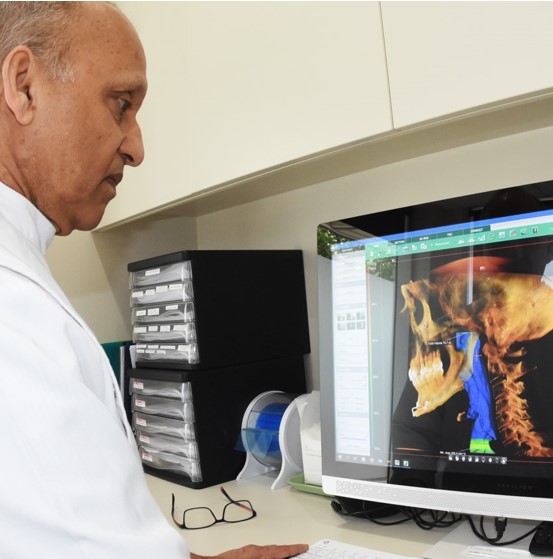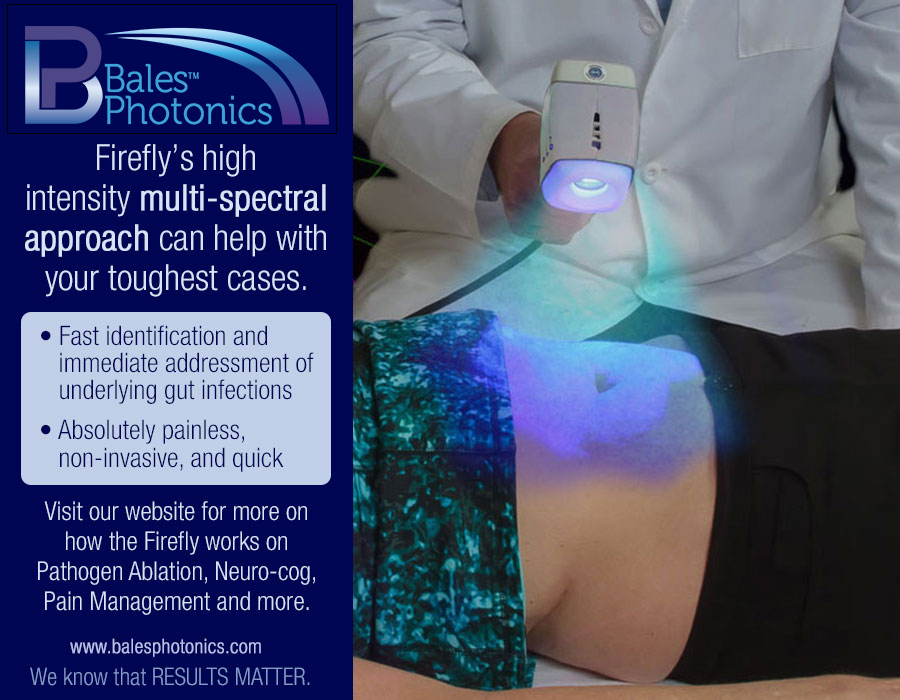Bob Frost

On a quiet street in southern Australia, in a large examining room filled with natural light, dentist Joseph Da Cruz examines the jaw of a 51-year-old patient named Carol, who has been plagued for years with headaches, poor sleep, fatigue, and thyroid issues. She has consulted with at least a dozen health professionals, including a Sydney physician who referred her to this office.
With sophisticated X-ray equipment, Da Cruz takes images of her mouth, and studies these. He presents Carol (not her real name) with a treatment plan, which includes creation of a customized dental appliance made of acrylic plastic, an adjustable plate that fits onto the upper teeth, developed by him over a period of years and patented globally.
“That’s why I’m here,” Carol says, “to get one of those things.”
“We can have it for you in three weeks,” says Da Cruz, and Carol smiles broadly, as if, after years of suffering, there’s hope on the horizon.
The device is known as a “SOMA,” short for “Splint Orthopedic Myofunctional Appliance.” It makes the jaw work better. With extreme gentleness, it moves the jaw into its proper alignment and ideal physiological position. This relaxes facial and jaw muscles. Relaxation (“decompression”), accompanied by cranial release, reduces stress and strain in the cranium/neck/jaw complex and thus in the entire body, says Da Cruz. The nervous system is calmed; there is a reduction in dominance by the overly reactive sympathetic nervous system (which controls the “flight-or-flight” response) and there’s enhancement of the parasympathetic nerves. Life energy flows more freely, Da Cruz says (“qi,” to use the Chinese word) and the body moves to a new place of healing.

The result, according to Da Cruz, can be improvement in many bodily functions, including breathing, sleep, digestion, the immune system, allergies, chronic fatigue, depression, anxiety, lymphatic drainage, cerebrospinal fluid flow, hormone production, mental focus, etc. “And,” he adds, “the appliance will alleviate many types of chronic pain, including headaches.” There are no guarantees, he says, but he believes that many people, from age six up, could benefit from a SOMA—many or most people have jaw muscles that are extremely and unnecessarily tight, he says.
As an example of a bodily structure helped by the SOMA, he mentions fascia, the connective tissue system made of collagen, “often obstructed by chronic muscle tension,” he says. This tension, and the resulting inflammation, can cause chemical changes in fascia fibers, he continues, which obstructs acidic waste removal and prevents normal hormone activity.
The SOMA can also assist in orthodontics. “Most orthodontists deal with the horizontal architecture of the teeth and jaw,” Da Cruz says. “That’s the easy part. What’s harder is what I do—dealing with the horizontal problem, the vertical problem, and the backto-front problem, as well as TMJ, occlusion, clenching, and mouth breathing.”
Da Cruz has fitted several thousand patients with his appliances at his office in Quenbeyan, a small city near Canberra, Australia’s capital. Most of his patients are from Australia; he has also worked with people from North America, Europe, Japan, the Middle East, etc.
The SOMA device is part of a quiet revolution in dental care under the broad heading of physiologic/neuromuscular/biological dentistry.
Born in 1950 in Goa, India, Da Cruz grew up in Nairobi, Kenya. He was a feisty kid, he recalls—independent-minded and athletic, a dedicated field hockey player, a champion arm wrestler, capable of doing dozens of pull-ups while his classmates barely managed one or two—a ball of fire, eager to make his mark in the world.
He received an excellent dentistry education in India, finishing near the top of his class and getting a master’s degree. Emigrating to Australia in 1979 in search of better opportunities, he built a successful general dentistry practice and began raising a family.
In the 1980s he began re-thinking the shibboleths of his profession when one of his patients, a man with eight mercury-based fillings, wanted them removed. Da Cruz investigated the matter, consulted with peers, took safety precautions, and did the work. The patient was pleased.
In 1993, in Canberra, Da Cruz met John Diamond, MD, an Australian-trained psychiatrist and author, a polymath who had investigated many modes of complementary healing, including the dental work of Willie May, DDS, of Albuquerque, New Mexico, who created appliances that appeared to help many health issues. Diamond and Da Cruz discussed May’s work for hours on end. They also talked about neurology, kinesiology, Chinese medicine, orthomolecular therapy, naturopathy, and birth trauma. The latter greatly affects the neck, Diamond said, and may in fact be the core cause of human suffering.
They studied the vertebrae, including its topmost bone, the atlas, just below the skull. This structure has drawn the attention of many health thinkers over the centuries including F.M. Alexander of Alexander Technique fame. The atlas, said Da Cruz and Diamond, is one of the great connecting points of the body, a bridge between the conscious mind (above the atlas) and the unconscious (below).
They delved into the complex cranial-release theories of osteopaths Andrew T. Still, William Sutherland, and Robert Fulford. “I needed years of study to really figure out cranial release,” says Da Cruz.
They pondered holism, the notion that the entire body is connected, that jaw dysfunction can affect overall well-being, and that the mind, emotions, and spirit are part of the overall package. Da Cruz’s summary of this theory: “Structures that extend from the maxilla facial region have profound effects on the human body.”
Thus prepared, Da Cruz was inspired by a night-time dream. (Many interesting things have come forth from dreams, of course, including Albert Einstein’s Theory of Relativity.) In 1994, while asleep one night, Da Cruz saw, in vivid three-dimensional detail, an appliance that he could build, a device that would free the jaw and cranium. He set to work, and a year later, his first SOMA device was ready. He patented it. In 2022 he was granted a provisional US patent for a newer version of the appliance, investing hundreds of thousands of dollars in legal fees (patent #200-427-7278).
In 2023, Da Cruz has lined up his ducks and is ready to tell the world about his work. He has perfected the SOMA and has found the exact right laboratory to respond forthwith to his instructions.
At age 72, he has the vibe of someone 10 years younger who has taken good care of himself—a youthful face, a spirited walk, abundant energy. He attributes his vigor to nightly use of a SOMA, regular exercise, diaphragmatic breathing, heredity, adequate hydration, and a carefully-planned diet that emphasizes low acidity and a balance of yin and yang foods. He also mentions the value of placing the tip of his tongue gently on the roof of his mouth and keeping it there (which the SOMA allows).
Dentistry, he says, can do more for general health than most people think. Mainstream dentistry, he says, is tragically lacking in imagination: “I believe that current dental work, for the most part, is much too narrowly focused, not interested enough in the broad health benefits that enlightened dentistry can offer. Dentists can provide effective, safe treatment for a wide range of conditions.”
The science of the jaw is extremely complicated and has attracted the attention of many researchers and practitioners.
Some of the roots of modern dental appliances can be found in the early 1900s in the work of Moritz Karolyi, who devised an occlusal guard to prevent chronic night-time teeth grinding and clenching (bruxism). The Michigan Splint came along in the 1950s and ’60s and is a standard treatment for TMJ.
Since the 1980s, biological dentistry has gained popularity. An aspect of it is holism. The appliance realm has expanded to embrace holism. “Whole body enhancement from a dental approach” is a phrase that has come to the fore.
One of the most prominent in the new generation of appliances is the ALF family of devices (ALF stands for “Advanced Light Force”) introduced in the ’80s by Dr. Darick Nordstrom of Hollister, California, and revised over the years—welcomed by many dentists and osteopaths as a way of changing the jaw in a gentle way; criticized by others as nontraditional.
Also part of the new generation: John and Mike Mew in Britain, Dave Singh and Theodore Belfor in the US, and a handful of others.
The SOMA is part of the new generation.
Jasmine R. Elmore, DDS, is an airway-focused dentist and specialist in breathing behavior in Raleigh, North Carolina. She has studied appliances, analyzing their efficacy, comprehensiveness, and cost-effectiveness. The SOMA, she says, is the best such product available. She comments, “I have a SOMA. I feel it has significantly enhanced my health, in conjunction with breathwork and other healing modalities. I was suffering from colitis; I’m now recovering, feeling calmer, more focused, more energized.”

Elmore opened a SOMA-only office in 2022. She is arranging for Da Cruz to give a demonstration and clinic in the US this year.
There are two ways to get a SOMA. One is consulting with Da Cruz in Quenbeyan. The city is three hours from Sydney by car. (Plane flights are available.) Da Cruz charges on a case-bycase basis. He has a comfortable guest house that he makes available for a moderate fee, across the street from his office. Motels are also handy.
The other way to get a SOMA is via a dentist instructed by Da Cruz in the technology. Da Cruz’s website has a list of people he has trained (www.wholisticdentistry.com.au). He welcomes visits from dentists who want to learn about his work. His team is developing an online training system.
Carol, the patient with the headaches and other symptoms, reports finding relief from the SOMA. Within three weeks her pain declined by 50 percent; within three months it fell by 90 percent, and her sleep and energy levels improved significantly.
Sidebar: This Man is On a Mission
“My mission,” says Omar Lalani, “is to ensure that every child grows with a healthy airway.”
Lanlani, 44, is a major fan of the SOMA. An engineer by training, he manages construction projects in Canada.
At age 11, as part of his orthodontic treatment, Lalani was prescribed a cervical headgear. This device, he says, is a “growth-binder” that can cause a person to have a narrower-than-normal airway, which can lead to obstructive sleep apnea (OSA), generating monumental fatigue and other negative effects.
While suffering from OSA, he studied orthodontic journals to better understand his situation, and found research that connected cervical headgears with OSA and underdevelopment. In 2015, he saw Joseph Da Cruz and was given a SOMA appliance. He quickly began recovering—his airway opened, his sleep improved dramatically, and his “brutal” headaches diminished. “Joe saved my life,” he says.
His mission today has three parts: putting an end to dental treatments that reduce airways; ensuring that people are made aware of treatment options that respect the airway; and educating parents on the importance of raising infants on foods with tougher consistencies (i.e., tougher than soft foods such as baby foods) so that chewing muscles are used properly.
“Some orthodontists avoid practices that impinge on airways,” he says. “These people need to have greater influence in their profession.”
Lalani’s website is RightToGrow.com.
Books Loved by Joe
Here are a few of the hundreds of books that have shaped the thinking of Joseph Da Cruz:
Your Body Doesn’t Lie by John Diamond (1979).
Life Energy by John Diamond (1990).
The Dental Physician by A.C. Fonder (1985 revised edition).
CranioSacral Therapy by John E. Upledger et al. (2008).
A Brain is Born by John E. Upledger (1996).
The Heart of Listening volumes 1 and 2 by Hugh Milne (1995).
Destructive Emotions by the Dalai Lama narrated by Daniel Goleman (2003).
The Brain That Changes Itself by Norman Doidge (2007).
Orofacial Pains by Welden E. Bell (various editions).
Orofacial Pain edited by Barry J. Sessle et al. (various editions).
Thoughts Without a Thinker by Mark Epstein (1995).
Sleep, Health & Consciousness by Reza Samvat and Henry Osiecki (2009).
Dr. Fulford’s Touch of Life by Robert C. Fulford (1996).
Breath by James Nestor (2020).
Published April 8, 2023
About the Author
Bob Frost is a journalist in San Francisco (bobfrostmail@aol.com). Technical explication of the SOMA is available at WholisticDentistry.com.au/what-does-soma-do. See also the online article “Two Dentists and Their Appliances” by John Diamond.

